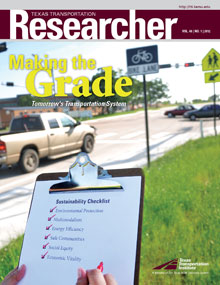The Texas Transportation Institute’s (TTI’s) Center for Transportation Safety (CTS) is beginning to examine the reasons why two distinct population groups — Hispanics and U.S. military personnel — are experiencing above-average crash rates at a time when overall crashes and traffic deaths have been reduced.
Because data show that Hispanics have a disproportionate risk of dying or being injured in traffic crashes, CTS has begun a Latino Traffic Safety Initiative (LTSI) to study this complex problem in Texas and offer countermeasure approaches.
Nationally, the figures are alarming:
- Motor-vehicle crashes are the leading cause of death for Hispanics ages 1–34.
- Hispanic children ages 5–12 are 72 percent more likely to die in a motor-vehicle crash than non-Hispanic children, and they are less likely to wear a restraint device.
- Hispanics are more likely to drive under the influence of alcohol or other drugs, and are more likely to be driving without a valid license.
The LTSI will first examine the Texas crash and fatality data. Do our state’s Hispanic figures reflect national statistics? Eventually, the goal of the LTSI is to determine if language barriers, education levels, socio-economic status and other cultural differences play a role in the crashes.
“In just nine years, the Hispanic population is expected to outnumber the non-Hispanic population in Texas,” says CTS Senior Research Scientist Katie Womack. “The more we learn about the reasons for the lopsided crash statistics, the better head start we’ll have on making travel safer for what will soon be the majority population. Everyone will benefit as a result.”
Meanwhile, a March 2011 article in the military publication Medical Surveillance Monthly Report caught the attention of CTS researchers. In it, crash data over an 11-year period were examined.
Citing the study, the article, entitled “Motorcycle and Other Motor Vehicle Accident-Related Deaths, U.S. Armed Forces, 1999–2010,” states: “Motor vehicle accidents (MVA) are the leading cause of deaths of U.S. military members during peacetime. During the four years prior to operations in Iraq and Afghanistan, one-third of all deaths of service members were caused by MVAs. Since the beginning of those operations, there have been nearly as many deaths of service members due to ‘transportation accidents’ as war related injuries.”
The article reported that more than 4,000 active-duty service members died in crashes during that period,with motorcycle deaths accounting for 24 percent of the fatalities.
“As the article points out, many of the crash victims are young, high-school-educated, single males — characteristics that could be associated with a higher risk of dying in crashes,” says Russell Henk, head of TTI’s Research and Implementation Division offices in El Paso and San Antonio. “We know motorcycle fatalities are overrepresented among our military service members — one of the key problem areas for which we hope to develop solutions.”
Henk, who is also the director of TTI’s Teens in the Driver Seat program, says elements of the successful high-school-targeted driver safety program — especially its peer-to-peer approach — could be used with the younger members of the military to address the crash-rate problem.
In exploring the CTS military initiative, contacts have been made with the Corps of Cadets at Texas A&M University, Ft. Hood in Killeen, Ft. Bliss in El Paso and military officials in San Antonio.

